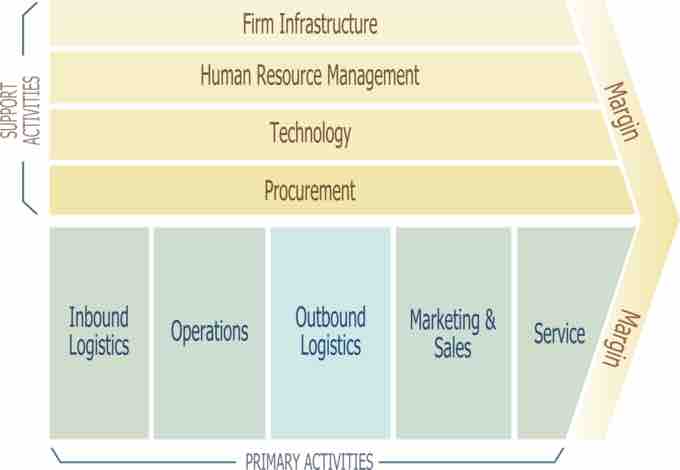Why Use Intermediaries
Product distribution is the way an organization moves a product into the hands of their consumers. Most organizations focus on the design and production of the product or service they sell, and not on the distribution channels that connect them to the users themselves. Instead, they outsource many of these aspects to intermediaries.
Intermediaries are specialists for a specific function along the value chain. This could include distribution, marketing, sales, retail, e-commerce, web development, branding, packaging, storing, and a variety of other functions. Collaborating with one or more partners can enable an organization to focus on what it is that they do best (core competency) and, in turn, outsource other aspects of the value chain to organizations who are best at that particular function.

Porter Value Chain
Understanding the value chain is central to the concept of intermediaries. The value chain shows all the steps a business must take to get a product developed from the raw materials and into the hands of the consumer. Organizations benefit significantly from understanding the opportunity cost of intermediaries.
Common Intermediaries
Distribution
Some of the most common intermediaries are related to product distribution. Moving a good from the producer to the buyer is a logistically complex and resource-heavy process. Ensuring that shipping resources are available (e.g., trucks, ships, planes, and trains primarily) and that items move from supplier to warehouse to user is often handled by an intermediary such as Fedex or UPS. These organizations can utilize economies of scale and a vast network of resources to offer highly specialized delivery services at a relatively low cost and, more importantly, low risk.
Retail
Buying real estate to store and sell physical goods can be extremely cost prohibitive. Investing in retail outlets all across the world requires a huge amount of fixed investments, and likely will incur a high amount of debt. This debt is a business risk most smaller producers do not want to incur. As a result, they sell their items wholesale to various retail outlets. This allows both parties to mitigate risk, as the retailer can sell a variety of goods without having to produce them all, and the producer can acquire sales channels across the globe without investing significantly in real estate.
Consider a store like Macy's, where the shelves are stocked with brand name goods. Macy's in downtown Manhattan is an expensive piece of land, but the suppliers themselves are not liable for the purchase and maintenance of that property. Instead, Macy's diversifies its portfolio of goods while producers provide them at lower wholesale prices to share risk.
Ad Agencies
Another popular intermediary is the ad agency. Ad agencies specialize in building communities and brands, utilizing a wide variety of paid and organic channels. This can include social networks such as Facebook, Linkedin, Twitter and Instagram, as well as paid ad production on popular TV channels or affiliate advertising. Ad agencies utilize the entire marketing mix (and more, nowadays) to craft customized brand building initiatives centered on the unique target market and product of their strategic partners.
E-commerce and Web Development
Maintaining an online storefront nowadays is relatively straight-forward, so more and more companies do this internally now. However, managing a large e-commerce team with strong web development skills (such as copy, graphic design, UX, and other e-commerce roles) can become a pricey endeavor. As a result, some organizations prefer outsourcing this as well.
Amazon is a great example of an e-commerce website designed to enable smaller businesses. Amazon actually handles quite a bit of intermediary responsibilities (i.e. shipping, storing, and e-commerce for starters). The value Amazon adds is not only limited to the skills of building strong websites, however. Amazon has a huge and loyal following of consumers, which makes them an attractive potential strategic alliance for many smaller firms.
Conclusion
What's most important to understand about intermediaries is that they are a trade-off, where an organization recognizes the value of outsourcing a function relative to the opportunity cost of building that competency internally. When considering working with a third party, consider the core competency of that partner compared to the core competency of your own organization and determine if synergy exists (as opposed to redundancy).